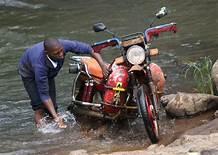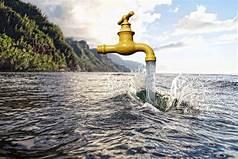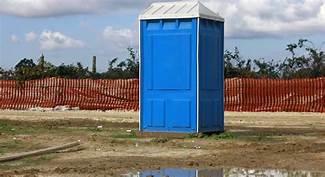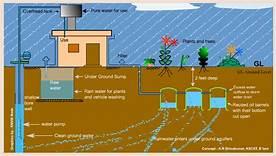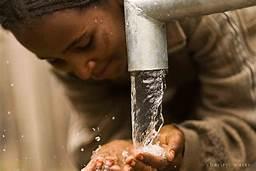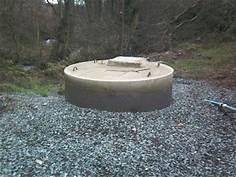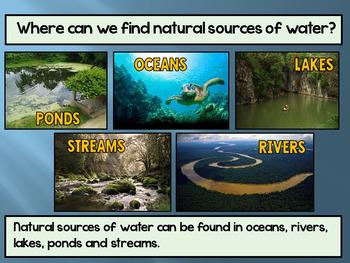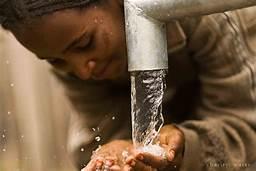8th Grade: How Much Do You Actually Know About Earth Science?
-
What is an advantage of boreholes over hand dug wells?
-
They require a pump to bring up the water from the depths
-
Since they reach the water table, they are a more reliable and cleaner source of water
-
They need the area to be surveyed to find the correct location for the well to be sunk
-
They require equipment and skills that often have to be brought in
-
While our planet is 70% water only 3% of that water is available as freshwater - and two-thirds of that are locked up as ice! 1.1 billion people in the world don’t have access to safe drinking water, and a further 2.7 billion find it difficult to get access to clean water for at least one month of the year.

Quiz Preview
- 2.
What is one of the main reasons domestic use of water is higher in MEDCs than in LEDCs?
-
People in MEDCs tend to drink more water
-
Labour saving devices, such as washing machines and dishwashers, are more popular in MEDCs
-
In MEDCs, people leave the taps running when not needed
-
Fishponds and swimming pools are much more common in MEDCs
Correct Answer
A. Labour saving devices, such as washing machines and dishwashers, are more popular in MEDCsExplanation
In MEDCs, the higher domestic use of water can be attributed to the popularity of labour-saving devices such as washing machines and dishwashers. These devices require a significant amount of water to operate efficiently, leading to increased water consumption in households. In LEDCs, where such devices are less prevalent, the domestic use of water is comparatively lower.Rate this question:
-
- 3.
Which of the following is not a problem with water supplies in LEDCs?
-
Lack of available clean water
-
Diseases spread via the water supply
-
Water pollution
-
There is no water available
Correct Answer
A. There is no water availableExplanation
The correct answer is "There is no water available". This is not a problem with water supplies in LEDCs because the question is asking for a problem that is not present. The other options - lack of available clean water, diseases spread via the water supply, and water pollution - are all common problems faced by LEDCs in relation to their water supplies.Rate this question:
-
- 4.
How does providing appropriately built and sited toilets increase the availability of fresh water in locations with no running water supplies?
-
Toilets can contaminate wells and other water sources with raw sewage if inappropriately built or sited
-
Placing toilets far from a settlement will mean less of its fresh water is used for waste disposal
-
Using waste water to flush toilets will save fresh water
-
Putting the toilets next to the well means that all the infrastructure is located together
Correct Answer
A. Toilets can contaminate wells and other water sources with raw sewage if inappropriately built or sitedExplanation
If toilets are not appropriately built or sited, they can contaminate wells and other water sources with raw sewage. This contamination can make the water unsafe for consumption or other uses, reducing the availability of fresh water in locations with no running water supplies. Therefore, providing appropriately built and sited toilets can help prevent this contamination and ensure the availability of clean and fresh water.Rate this question:
-
- 5.
Which of the following is not a method of harvesting water?
-
Collecting rainwater off roofs
-
Damming areas to catch runoff during times of heavy rainfall
-
Borehole drilling to reach the water table
-
Storing water from rivers during seasonal high waters or flooding
Correct Answer
A. Borehole drilling to reach the water tableExplanation
Borehole drilling to reach the water table is not a method of harvesting water because it involves extracting water from underground sources rather than collecting it from surface runoff or rainfall. Harvesting water typically refers to the collection and storage of surface water, such as rainwater or river water, for various purposes like irrigation or domestic use. Borehole drilling, on the other hand, is a method used to access groundwater for extraction through wells or boreholes.Rate this question:
-
- 6.
Which of the following is not a way that providing clean water benefits local populations?
-
It reduces disease and illness from contaminated water
-
It increases the time available for work and education
-
It reduces the cost of drinking water
-
It allows local businesses to profit by selling clean water at high cost
Correct Answer
A. It allows local businesses to profit by selling clean water at high costExplanation
Providing clean water benefits local populations in several ways. Firstly, it reduces disease and illness caused by contaminated water, improving overall health and well-being. Secondly, it increases the time available for work and education as people spend less time fetching water from distant sources. Thirdly, it reduces the cost of drinking water, making it more affordable for the local population. However, the statement "It allows local businesses to profit by selling clean water at high cost" is not a way that providing clean water benefits local populations. Instead, it suggests a potential negative impact where businesses exploit the need for clean water by charging high prices, potentially making it unaffordable for some individuals.Rate this question:
-
- 7.
Charities often report that they are providing new spring fed systems in areas that already have a non-functioning one. Why might it be the case that the systems provided are falling into disrepair?
-
The local population lack the skills and tools to keep them repaired
-
The systems are designed so only the people that install them can maintain them
-
The local people would rather leave it for the charities to repair
-
The equipment is almost impossible to maintain without very expensive tools
Correct Answer
A. The local population lack the skills and tools to keep them repairedExplanation
The correct answer is that the local population lacks the skills and tools to keep the systems repaired. This suggests that the charities may not have provided proper training or resources to the local community, leading to a lack of maintenance and eventual disrepair of the systems.Rate this question:
-
- 8.
Why might wells be a suitable source of water?
-
The water will never become contaminated
-
They can be dug easily by hand
-
The water will never dry up if the water table lowers
-
Wells may collapse
Correct Answer
A. They can be dug easily by handExplanation
Wells can be a suitable source of water because they can be dug easily by hand. This means that even in areas without access to heavy machinery or equipment, wells can still be constructed to provide a source of water. This makes wells a practical and accessible option for obtaining water, especially in rural or remote areas where other sources may not be readily available.Rate this question:
-
- 9.
The Pergau Dam project was one in which the British Government agreed to build a dam to provide electricity and clean water in Malaysia. However, there was a condition - Malaysia purchased arms from Britain in return for the aid. It was later shown that the electricity could have been produced in a more effective manner. What is this sort of aid deal, where conditions are attached that do not benefit the poorest sections of the population, referred to as?
-
Tied aid
-
Brokered aid
-
International aid
-
Trade agreements
Correct Answer
A. Tied aidExplanation
Tied aid refers to a type of aid deal where conditions are attached that do not benefit the poorest sections of the population. In the case of the Pergau Dam project, the British Government agreed to provide aid to Malaysia, but with the condition that Malaysia purchased arms from Britain. This condition did not directly benefit the poorest sections of the population, as the aid was tied to a specific trade agreement rather than addressing their immediate needs for electricity and clean water.Rate this question:
-
- 10.
Which of the following is one way that education can help safeguard water supplies in poorer areas of LEDCs?
-
Teaching farmers to use less water intensive crops
-
Stop all pollution entering rivers
-
Increase the amount of water entering the system
-
Reduce flood events by reducing the amount people discharge into rivers
Correct Answer
A. Teaching farmers to use less water intensive cropsExplanation
Teaching farmers to use less water-intensive crops can help safeguard water supplies in poorer areas of LEDCs. By educating farmers on the benefits of planting crops that require less water, such as drought-resistant varieties or those with efficient irrigation techniques, the overall water consumption can be reduced. This approach promotes sustainable water management practices, conserves water resources, and ensures that water supplies are not depleted or overused in these areas.Rate this question:
-
Quiz Review Timeline (Updated): Oct 22, 2024 +
Our quizzes are rigorously reviewed, monitored and continuously updated by our expert board to maintain accuracy, relevance, and timeliness.
-
Current Version
-
Oct 22, 2024Quiz Edited by
ProProfs Editorial Team -
May 07, 2019Quiz Created by
Tutuagyekum
6th Grade: How Much Do You Actually Know About Earth Science?
Limestone was formed from the remains of organisms that lived in ancient seas. Large areas of beautiful countryside in the UK consist of limestone formed when the country was...
Questions:
10 |
Attempts:
307 |
Last updated:
Oct 23, 2024
|
Earth Science Quiz: 6th Grade Trivia Questions!
Earth Science/ Geography or Geology is the subject that deals with the study of the Earth and its lands, features, inhabitants, and phenomena. A literal translation would be...
Questions:
10 |
Attempts:
241 |
Last updated:
Mar 21, 2025
|
6th Grade: Do You Actually Know About Earth Science?
In tropical areas like the Caribbean, huge tropical storms called hurricanes (the same as typhoons in the Pacific Ocean or cyclones in the Indian Ocean) cause huge amounts of...
Questions:
10 |
Attempts:
259 |
Last updated:
Oct 23, 2024
|
6th Grade: A Trivia Quiz On Earth Science!
A natural resource is a material or source of energy that is supplied by nature. Unfortunately, obtaining and using these natural resources can be very destructive to the...
Questions:
10 |
Attempts:
616 |
Last updated:
Nov 13, 2024
|
8th Grade: Do You Actually Know About Earth Science?
Granite is an igneous rock that underlies a lot of highland Scotland and the south-west peninsula of England (Devon and Cornwall). Dartmoor is a good example of a typical granite...
Questions:
10 |
Attempts:
199 |
Last updated:
Oct 22, 2024
|
8th Grade Quiz: Test Your Knowledge About Earth Science!
By now, you will no doubt have learned that volcanoes occur in narrow belts in certain areas of the world. These belts also suffer earthquakes, and they mark out the areas where...
Questions:
10 |
Attempts:
164 |
Last updated:
Oct 22, 2024
|
 Back to top
Back to top



